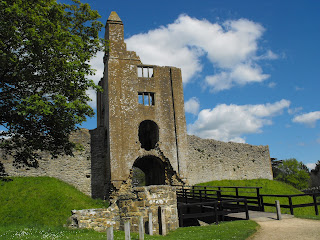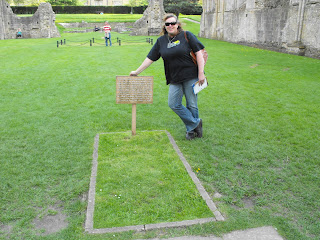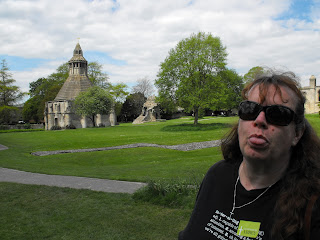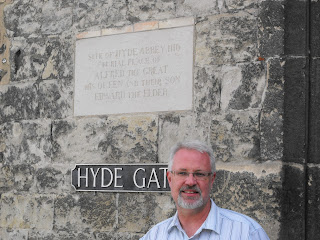WOW how time flies - it’s now mid June and we haven’t updated the blog since early May!! So much has happened - you’ll just have to catch up on facebook or skype (just kidding).
I’m not certain if we’ve told many people, but we are in quest of visiting the resting places of English monarchs - well without kids we gotta do something. We were wondering (OK, so Mark was wondering) if we could visit all of them, starting with the Anglo Saxon/Kings of Wessex - King Egbert, who died in 839, and whose bones now lie in Winchester Cathedral and finishing with King George VI in St George’s Chapel at Windsor Castle. A quick Google search later revealed that we’d hit a problem with at least 9 out of 65 since these are overseas (mainly in France) but some are also lost to all time - e.g. in the fire of London that destroyed Old St Paul’s Cathedral where Ethelred the Unready was buried.
There are a number of of the early Kings of Wessex sites sites near to Salisbury, so we headed off on Saturday 12th May in search of our first (King Edward, the Martyr, who died in 978, and was originally buried at Shaftesbury Abbey, Dorset). The next few entries might be a bit out of order as we just deal with the Kings - we’ll get back to the rest of the story soon. For information, I nicked the following picture that has the lineage of the Kings of Wessex to William the Conqueror from http://www.britroyals.com (so hopefully acknowledging this saves our copyright butts).
Shaftesbury
Saturday 12th May
The following map shows our path for the day - with Shaftesbury at “B”, Followed by Sherborne Old Castle and Sherborne Abbey at “C” and “D”. Along the way we revisited the Fovant stone badges, which date back to 1916 and include the Australian Army “rising sun” emblem - the kids might remember these as we visited them on the way to visit Sherborne Old Castle.
 Getting to Shaftesbury Abbey was quite interesting - our Tom Tom SatNav seems to take us the most bizzare routes - it doesn’t seem to matter if it’s put on eco, or fastest time - it still takes us via narrow winding country “roads”. We eventually parked in a very convenient location, just out of the very centre of town, and near a bridge that we just had to include here . . . the road markings are very ambitious to mark the road with a line down the middle - a 4WD only just squeezes on the entire bridge - so who would even contemplate parking here?
Getting to Shaftesbury Abbey was quite interesting - our Tom Tom SatNav seems to take us the most bizzare routes - it doesn’t seem to matter if it’s put on eco, or fastest time - it still takes us via narrow winding country “roads”. We eventually parked in a very convenient location, just out of the very centre of town, and near a bridge that we just had to include here . . . the road markings are very ambitious to mark the road with a line down the middle - a 4WD only just squeezes on the entire bridge - so who would even contemplate parking here?
Anyway we finally found the Abbey - probably one of the most destroyed that we’ve seen. It was founded by King Alfred in 888.
 What makes the Abbey famous is that it was the death place of King Knut (Cnut, Canute - take your pick) who was King from 1016 to 1035, buried at Westminster (see later).
What makes the Abbey famous is that it was the death place of King Knut (Cnut, Canute - take your pick) who was King from 1016 to 1035, buried at Westminster (see later).
It was also the resting place of Edward the Martyr. Edward was crowned King at 13 and was murdered 5 years later by members of the household of Aethelred II, the Unready at Corfe Castle in 978 (supposedly led by Aethelred’s step-mother). At the time of the dissolution the monks hid the Abbey’s priceless relics (including Edward the Martyr) and nobody knows where, so all we have is a supposed resting place - not a good start to our quest.
The "grave" with Cal next to it
Sherborne Old Castle
Saturday 12th May
I have no idea why we came back to Sherborne Old Castle - maybe because there wasn’t an English Heritage event on this time, and we could enjoy the ruins in more peace. When we visited this site in 2001, we came to see Lady Catherine and Thomas from English Heuristics. James will remember “killing” Thomas with a medieval “cure”. It’s also a stones throw from Sherborne Abbey which is where we were really headed.
Sherborne Abbey
Saturday 12th May
 The real reason for coming back to Sherborne was not to admire the distinctive architectural styles of Sherborne Abbey (well actually it was as it has some of the finest archtectural styles from Norman through Gothic to fan), but to look for two dead Kings.
The real reason for coming back to Sherborne was not to admire the distinctive architectural styles of Sherborne Abbey (well actually it was as it has some of the finest archtectural styles from Norman through Gothic to fan), but to look for two dead Kings. Æthelbald d.860 and Æthelbert d.866 were buried at Sherborne - and we found them - well, parts of them - their bones are visible in the Abbey, through some glass that is set into the floor. It struck us as quite odd that the relics would be on display - we would have thought that there’d be a little more respect - it was cool seeing the reaction of some of the visitors :-).
Æthelbald d.860 and Æthelbert d.866 were buried at Sherborne - and we found them - well, parts of them - their bones are visible in the Abbey, through some glass that is set into the floor. It struck us as quite odd that the relics would be on display - we would have thought that there’d be a little more respect - it was cool seeing the reaction of some of the visitors :-). Sherborne Abbey has architecture styles that include some of the original Saxon stonework, through the round arched Normal, the later pointed gothic, and some of the finest “fan vaulted” architecture in England - it also has some very nice stained glass :-). We also remembered a lovely piece of glasswork by Whistler that is quite beautiful (Mark wishes he had a better camera, but will wait till he goes to the U.S. or Sarah finds a great deal on UK ebay).
Sherborne Abbey has architecture styles that include some of the original Saxon stonework, through the round arched Normal, the later pointed gothic, and some of the finest “fan vaulted” architecture in England - it also has some very nice stained glass :-). We also remembered a lovely piece of glasswork by Whistler that is quite beautiful (Mark wishes he had a better camera, but will wait till he goes to the U.S. or Sarah finds a great deal on UK ebay). Glastonbury Abbey
Sunday 13th May
 We decided to do Glastonbury Abbey again, had 'done' it 10 years ago with the kids but the shop was shut so we didn't get a fridge magnet. shock, horror. Anyway, its a beautiful ruin & well worth a 2nd trip. On the way we saw a Reliant Robin - notice only 3 wheels! For those of you who watch Top Gear, its the type of car that they tried to send into space.
We decided to do Glastonbury Abbey again, had 'done' it 10 years ago with the kids but the shop was shut so we didn't get a fridge magnet. shock, horror. Anyway, its a beautiful ruin & well worth a 2nd trip. On the way we saw a Reliant Robin - notice only 3 wheels! For those of you who watch Top Gear, its the type of car that they tried to send into space.
It was also a lovely day, one of only 7 we've had since we've been here. Mark was busy with the camera & Cal suggested that he take a photo of a flower, well a weed really, clinging to some stone with the ruins in the background. Mark liked that idea & has since tried to get a similar photo at every place we've visited. Sometimes he looks really silly doing it. And its not Cal's fault no matter what he says!! But even if he looks silly, the photos look good.
 Glastonbury is also supposed to be the burial place of Arthur & Guinevere, as well as Edmund I d. 946 & Edgar d. 975. We couldn't find Ed & Ed but did find Art & Gwin. (Of course when the monks 'found' Art & Gwin they were in desperate need of money for repairs, not that I doubt a bunch of monks!!!)
Glastonbury is also supposed to be the burial place of Arthur & Guinevere, as well as Edmund I d. 946 & Edgar d. 975. We couldn't find Ed & Ed but did find Art & Gwin. (Of course when the monks 'found' Art & Gwin they were in desperate need of money for repairs, not that I doubt a bunch of monks!!!)
Some pics of Glastonbury
Stourhead House and Gardens
 After
that we went to Stourhead house & gardens, but only had time to
look thru the house. We'll go back to do the gardens another time. The
benefits of belonging to English Heritage & National Trust means we
don't have to feel we're wasting money if we don't get to do everything
all at once. On the way there we saw a very quaint sign, that we had to
do a U-turn for . . .”Church View” formally Twaddle Alley !!!!
After
that we went to Stourhead house & gardens, but only had time to
look thru the house. We'll go back to do the gardens another time. The
benefits of belonging to English Heritage & National Trust means we
don't have to feel we're wasting money if we don't get to do everything
all at once. On the way there we saw a very quaint sign, that we had to
do a U-turn for . . .”Church View” formally Twaddle Alley !!!!
Stourhead
is described as a Palladian mansion & world-famous landscape
garden. The house was owned by the Hoare family before it was given to
the Nat Trust. Plenty of Chippendale furniture & lots of paintings
as well as a Regency library. The estate is 2 650 acres!
This is a picture of the "snow flake" chandalier
One of the many photos of paintings in the house
 It
also has a rather nice tea house where Cal had a 'cream tea' which is
what they call a devonshire tea. Don't know why we call it 'devonshire'
cause the jam always comes from the area & the cream is always
Cornish clotted cream (yum!) Yes, bad for the diet but weekly bonus
points are always saved for a cream tea every week, not that Cal gets
one every week.
Anyway, we won't be doing the gardens this weekend as they are closed
because of the high winds forecast for Saturday - oh joy!
It
also has a rather nice tea house where Cal had a 'cream tea' which is
what they call a devonshire tea. Don't know why we call it 'devonshire'
cause the jam always comes from the area & the cream is always
Cornish clotted cream (yum!) Yes, bad for the diet but weekly bonus
points are always saved for a cream tea every week, not that Cal gets
one every week.
Anyway, we won't be doing the gardens this weekend as they are closed
because of the high winds forecast for Saturday - oh joy! Winchester
Saturday 9th June
 OK,
so before the obligatory history lesson we thought we’d show you some
of the Cathedral. We visited the treasury, where they have plates and
cups dating back a very long way - this one is of a plate that was until
recently the oldest paten in continuous use. It reads (translated) All
things I make; By divine strength I rule; By Godliness I reform - dated
c1230.
OK,
so before the obligatory history lesson we thought we’d show you some
of the Cathedral. We visited the treasury, where they have plates and
cups dating back a very long way - this one is of a plate that was until
recently the oldest paten in continuous use. It reads (translated) All
things I make; By divine strength I rule; By Godliness I reform - dated
c1230.
The Holy Sepulcher Chapel
A view from a higher vantage point
This beautiful statue is in the Norman Crypt, which often floods :-)
 Back
to the Kings . . . . It was hard to determine who was the first of the
Kings of England - was it William the Conquerer? or earlier - if earlier
then who, as many of the “kings” were actually tribal chieftains. To
cut a long story short, Edward the Great - a Wessex king is regarded as
the first of the kings of England. His Old English name is Ælfrǣd, which
means "elf counsel" (right, and that makes sense in a king!!!) and was
King of Wessex from 871 to 899. He is the only English monarch to be
accorded the title "the Great", and he also called himself "King of the
Anglo-Saxons". One of the reasons why he is regarded as the first King
of England is that he was regarded as a merciful man who encouraged
education and improved his kingdom's legal system and military
structure.
Back
to the Kings . . . . It was hard to determine who was the first of the
Kings of England - was it William the Conquerer? or earlier - if earlier
then who, as many of the “kings” were actually tribal chieftains. To
cut a long story short, Edward the Great - a Wessex king is regarded as
the first of the kings of England. His Old English name is Ælfrǣd, which
means "elf counsel" (right, and that makes sense in a king!!!) and was
King of Wessex from 871 to 899. He is the only English monarch to be
accorded the title "the Great", and he also called himself "King of the
Anglo-Saxons". One of the reasons why he is regarded as the first King
of England is that he was regarded as a merciful man who encouraged
education and improved his kingdom's legal system and military
structure.
So
who was at Winchester? So much history it’s hard not to tell - we met a
lovely lady in the Cathedral as we were looking for the bones, and she
was a wealth of information. Anyway, there are now six mortuary chests
(used to be eight) in the cathedral that contain the remains of:
Cenwalh d.672
Egbert d.839
Æthelwulf d.855
Eadred d.955
Eadwig (Edwy) d.959
Canute the Great d.1035
Harthacanute d.1042
William II (Rufus) d.1100
A list of the relics Cal outside the Alter with the chests
Cynegils
and Cenwalh were bonuses for us as they weren’t really Kings of
England, rather the first Kings of Wessex who invaded in the country in
the early 7th century. King Canute (Knut) the Great was a Danish King
(and one of the Kings of Wessex). The only reason we single him out is
because he was attributed as saying: “Let all me know how empty and
worthless is the power of kings, for there is none worthy of that name
but God, whom heaven and earth and sea obey”. He died at Shaftesbury
Abbey (see above) Pretty cool. William II (also known as Rufus) was the
elder son of William the Conquerer, so we “met” our first Normal King as
well!
 Outside the Cathedral, we had to walk to the remains of Hyde Abbey where Alfred the Great and his son Edward the Elder were originally buried. On the way we past Worthy Lane - not as good as our street “Wellworthy Drive” :-)
Outside the Cathedral, we had to walk to the remains of Hyde Abbey where Alfred the Great and his son Edward the Elder were originally buried. On the way we past Worthy Lane - not as good as our street “Wellworthy Drive” :-)
Only the gatehouse remains to this day. - but that was good enough for us :-)
Alfred the Great d.899
Edward the Elder d.924
 Of course there was the (now obligatory) flower with ruin in background photo.
Having visited Winchester, there are only five other pre-Norman kings to visit - including Harold Godwinson, who we could have seen when we visited Norfolk for the Queen’s jubilee (if we’d had our thinking caps on). The rest of the Kings and Queens are mainly in Windsor (St George Chapel) and Westminster.
Of course there was the (now obligatory) flower with ruin in background photo.
Having visited Winchester, there are only five other pre-Norman kings to visit - including Harold Godwinson, who we could have seen when we visited Norfolk for the Queen’s jubilee (if we’d had our thinking caps on). The rest of the Kings and Queens are mainly in Windsor (St George Chapel) and Westminster. 

































Wow! Long blog! I look forward to the next kingly entry. Sounds like fun! I remember a couple of those places too. Just one suggestion: Dad, let Mum take a few more pics of you. And it would be nice if you could get some pics together :-)
ReplyDelete